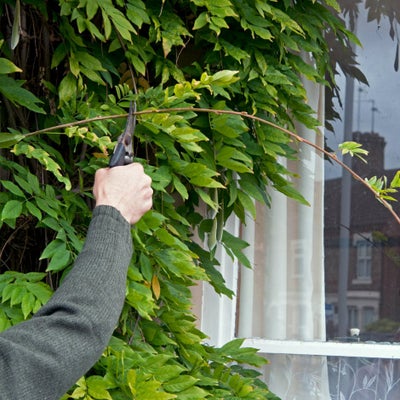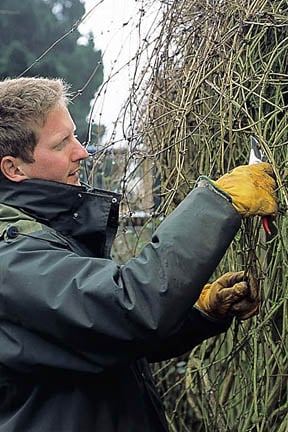
Quick facts
Suitable for - Wisteria
Timing - Twice a year in Jan-Feb and Jul-Aug
Difficulty - Moderate
When to prune wisteria
Wisteria is best pruned twice a year, in July/August and January/February.
How to prune wisteria
Wisterias can be left to ramble unchecked where space allows, but will usually flower more freely and regularly if pruned twice a year.
- The removal of growth in summer allows better air circulation and more sunlight to reach the base of the young growths, encouraging better ripening of the wood and improving the chances of flower formation.
- Restricting the amount of vegetative growth and encouraging short flowering spurs will result in more flowers.
How to summer prune wisteria
After flowering, in July or August, cut back the whippy green shoots of the current year’s growth to five or six leaves.
This controls the size of the wisteria, preventing it from growing into guttering and windows, and encourages it to form flower rather than green growth.
How to winter prune wisteria
In January or February (when the plant is and leafless), cut back the shoots you pruned in summer to two or three buds, to tidy up the plant before the starts. This also ensures the flowers won’t be hidden by leaves.
How to hard prune or renovate wisteria
With older plants, severe pruning may be needed to remove old, worn-out growths, or branches growing over windows or protruding outwards from the face of the building. Likewise, hard pruning maybe required where maintenance needs to be carried out on the structure supporting the plant.
Drastically shortening back long branches, removing sections of older stems to just above a strong young branch or growth shoot lower down, or cutting completely back to a main branch, or even to ground level may be necessary. A careful, unhurried approach is needed if larger, thicker branches are to be removed and where a branch is twining it may be necessary to trace back and mark it at intervals with string before removing it. The end result should be a skeleton frame work of reasonably well-spaced branches.
Other points to consider when hard pruning;
- Hard pruning will stimulate strong, new growth so it is better to avoid feeding in the first spring after hard pruning
- If there are gaps in the framework suitably positioned new growths can be trained in to form replacement branches, with flowering usually resuming in two or three years’ time. Often there is strong basal shoot growth
- If unwanted for replacement branches they can be removed. Any such pruning can be done during the period from leaf fall to early February
- Other new growths can be pruned back summer and winter as for normal routine pruning

Other ways to train wisteria
On walls
The ideal way to grow wisteria against a wall is to train it as an espalier, with horizontal support wires (3mm galvanised steel) set 30cm (1ft) apart. Over time, and with pruning twice a year, plants will build up a strong spur system. Use new growths that develop near the base of plants as replacement shoots, if necessary, or cut out at their point of origin.
On pergolas and arches
Wisterias with long flower racemes are best admired on structures where they can hang free, unimpeded by branches or foliage. For the best flowers, reduce the number of racemes by out to give those that remain plenty of space to develop.
Growing into trees
Wisteria can be trained to grow up into the canopy of a small tree, but to the possible detriment of the tree. Growing into large trees can make pruning of the wisteria difficult, and flowering may be affected if the leaf canopy is dense. If you choose to grow into a tree, plant the wisteria on the south side of the tree, 1m (3ft) away from the trunk.
Training as a standard
Standard wisterias can be grown either as specimens in a border, or in a large pot.
- Start with a young, single-stemmed plant, and insert a 1.2-1.5m (4-5ft) stout support next to it when you plant into the ground or container. This will be used to create the main stem of the ‘lollipop’
- If planting in a pot, John Innes No 3 potting is a good choice of compost. Make sure the wisteria is planted to the same depth as it was in its pot from the nursery, spreading out the roots and loosening the root ball before planting. Choose a cheap container that is only slightly larger than the plant needs, potting it on gradually as it grows to fill its final display container
- Train the stem vertically up the support (this is usually stronger than twining)
- Allow the plant’s leader to grow unchecked until it reaches the top of the support and then remove the tip in the following February to encourage the formation of sideshoots
- Prune the sideshoots the following winter, shortening them to 15-30cm (6in-1ft) and repeat this process each winter to gradually build up a head
- Weak or misplaced growth can be cut out entirely, as can older branches if the head becomes too dense in later years
- As the head develops, prune in August as well. Cut off above the seventh leaf any shoots that are not needed to extend the head
- The following February cut back these shoots to 2.5cm (1in) of their bases, just as you would routinely prune a wall-trained plant
Problems
See our page on frequently asked questions on wisteria problems.








